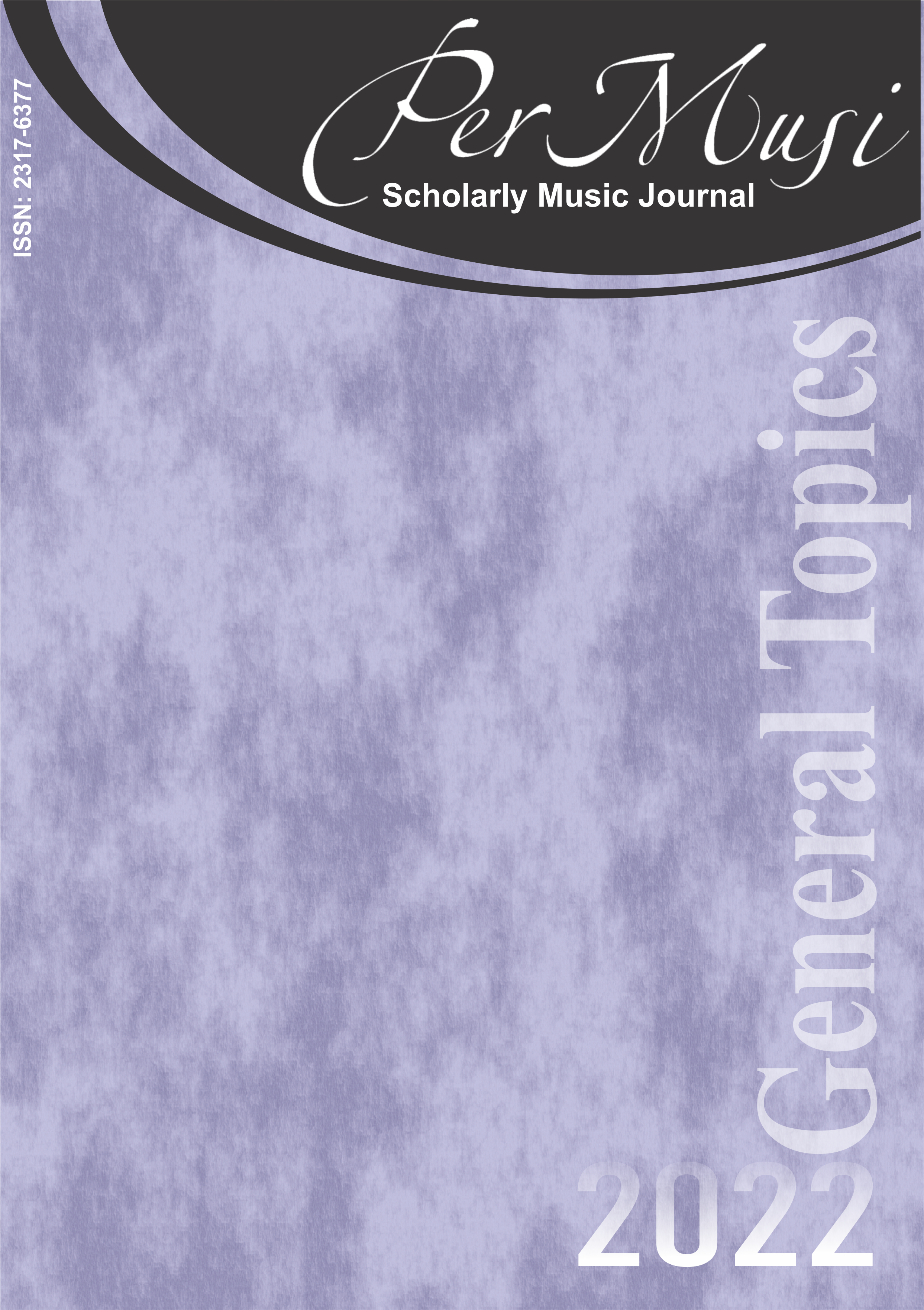Os arcos barroco, de transição e moderno sob a égide positivista
uma discussão sobre o conceito de evolução tradicionalmente aplicado ao desenvolvimento do arco de violino
DOI:
https://doi.org/10.35699/2317-6377.2022.37881Palavras-chave:
Arco de violino, Arco barroco, Arcos de transição, Arco moderno, Positivismo e músicaResumo
Na historiografia do arco de violino, é comum defrontar-se com a concepção de uma sequência linear e progressiva em seu desenvolvimento no transcorrer dos séculos, marcada pelo aperfeiçoamento de um espécime rudimentar rumo à perfeição do arco moderno. Violinistas referenciais do século XIX, como Woldemar e Baillot, bem como o historiador Fétis, desenvolveram quadros que ensejam a caracterização de uma evolução do arco. Trata-se, no entanto, de uma noção marcada pelo pensamento positivista. Essas imagens, amplamente reproduzidas em livros e artigos, cristalizaram uma realidade distinta daquela apresentada pela tratadística e pela iconografia dos séculos XVII ao XIX. Neste artigo, procuramos demonstrar, por meio de extensa revisão bibliográfica e análise iconográfica, que inúmeros modelos de arco coexistiram na prática musical entre 1600 e 1850 – tendo em vista a diversidade das necessidades impostas pelos instrumentistas, gêneros e estilos –, e que uma compreensão histórica destes, somente através de um prisma evolutivo, seria reducionista.
Referências
Ablitzer, Frédéric, Nicolas Dauchez, Jean-Pierre Dalmont, and Nelly Poidevin. 2009. “Mécanique de l’archet de violon: lien entre évolution et répertoire musical.” 5e Congrès Interdisciplinaire de Musicologie. 1-7. hal-00586651.
Akoka, Jérôme. 2015. “A history of 18th-century bows.” Tarisio. October 10. https://tarisio.com/archet-revolutionnaire/historical-introduction/ Acesso em: 04 de outubro de 2021.
Bachmann, Werner, Robert E. Seletsky, David D. Boyden, Jaak Liivoja-Lorius, Peter Walls and Peter Cooke. 2001. “Bow” Grove Music Online. Disponível em: https://doi.org/10.1093/gmo/9781561592630.article.03753. Acesso em: 03 de novembro de 2021.
Baillot, Pierre. 1834. L’Art du Violon: Nouvelle Méthode. Mayence et Anvers: Chez les fils de B. Schott.
Barros, José D’Assunção. 2011. “Considerações sobre o paradigma positivista em história.” Revista Historiar, 4 (4): 1-20. Sobral, Ceará: Universidade Estadual Vale do Acaraú.
Bellintani, Adriana Iop. 2009. “O Positivismo e o Exército Brasileiro.” In: ANPUH - XXV Simpósio Nacional de História. 1-9.
Bosi, Alfredo. 2004. “O positivismo no Brasil: uma ideologia de longa duração.” In: Do positivismo à desconstrução: idéias francesas na América Organizado por Leyla Perrone-Moises São Paulo: EDUSP.
Brémaud, Iris, and Nelly Poidevin. 2009. “Approches culturelles et mécaniques dans le choix des bois en facture: cas des archets anciens.” 5th Conference on Interdisciplinary Musicology. 1-19. hal-00808357.
Buelow, George J. 2001. “Athanasius Kircher” Grove Music Online. Disponível em https://doi.org/10.1093/gmo/9781561592630.article.15044. Acesso em: 21 de agosto de 2021.
Damas, Carlos Alexandre. 2012. “Violino e Tecnologia: Origem e evolução tecnológica entre os séculos XV e XXI”. Dissertação de Mestrado em Música. Lisboa: Universidade Nova de Lisboa.
Dilworth, John. 1992. “The violin and bow - origins and development.” IN: The Cambridge Companion to the violin. Organizado por Robin Stowell. Cambridge: Cambridge University Press, 1-29.
Faustino, Rosângela, João Gasparin. 2001. “A influência do positivismo e do historicismo na educação e no ensino de história.” Acta Scientiarum, 23 (1) 157-166.
Fétis, François-Joseph. 1856. Antoine Stradivari: luthier célèbre, connu sous le nom de Stradivarius. Paris: Vuillaume.
Fétis, François-Joseph. 1867. Biographie Universelle des Musiciens et Bibliographie Générale de la Musique. Vol. 8. 2a ed. Paris: Librairie de Firmin Didot Frères, Fils et Cie.
Fomin, Igor, Lucas Guilherme Schafhauser, Jorge Luis Monteiro Matos, Silvana Nisgoski, and Thiago Corrêa Freitas. 2018. “O arco de violino.” Revista Brasileira de Ensino de Física. 40 (4) e4303.
Gaudfroy, Bernard. 2001. “La naissance de l’archet moderne.” Les Amís de L’alto http://amisdelalto.over-blog.fr/article-la-naissance-de-l-archet-moderne-par-bernard-gaudfroy-86461562.html Acesso em: 01 de setembro de 2021.
Gaudfroy, Bernard. 2015. “Life & work for 18th century parisian bow and violin makers by Bernard Gaudfroy.” Tarisio.
https://tarisio.com/archet-revolutionnaire/parisian-bow-makers-bernard-gaudfroy/ Acesso em: 05 de janeiro de 2022.
Iskandar, Jamil, Maria Leal. 2002. “Sobre Positivismo e Educação.” Revista Diálogo Educacional, Curitiba, 3 (7) 89-94.
Koepp, Kai. 2015. “French or German bows for Beethoven.” Tarisio. https://tarisio.com/archet-revolutionnaire/kai-koepp-french-or-german-bows-for-beethoven/ Acesso em: 07 de janeiro de 2022.
Labadens, Jean-Baptiste. 1772. Nouvelle Methode pour apprendre à jouer violon, et à lire de la Musique; enrichie de plusieurs Estampes en taille douce. Paris.
Liivoja-Lorius, Jaak. 1984. “The Bow.” In: The book of the violin. Organizado Dominic Gill. New York: Rizzili International Publications, Inc. 48-58.
Marissen, Michael. 1993. “Religious aims in Mendelssohn’s 1829 Berlin-Singakademie Performances of Bach’s St Matthew Passion.” The Musical Quaterly (Oxford University Press) 77 (4).
Mersenne, Marin. 1636. Harmonie Universelle. Paris: Sebastien Cramoisy.
Mozart, Leopold. 1756. Versuch einer gründlichen Violinschule. Augsburg: Johan Jacob Lotter.
Mozart, Leopold. 1770. Méthode reaisonnée pour apprendre a jouer du violon. Traduzido por Valentin Rœser. Paris: Mr. Le Menu.
Mozart, Leopold. 1985. A treatise on the fundamental principles of violin playing. Traduzido por Editha Knocker. Oxford: Oxford Univeristy Press.
Poidevin, Nelly. 2009. “Une histoire de l’archet de violon de la renaissance au tournant de XIXe siècle.” https://www.archets-poidevin.com/a-la-pointe-de-lhistoire-de-larchet/ Acesso em: 05 de janeiro de 2022.
Reis, Adonhiran. 2019. A prática de quarteto de cordas: aspectos técnico-interpretativos e históricos. Curitiba: Editora Appris.
Reis, Adonhiran, Marcus Held. 2021. “O conceito de escolas de violino e sua atual aplicabilidade no Brasil.” Opus 27 (3) 01-22. http://dx.doi.org/10.20504/opus2021c2707
Ribeiro, Roger Lins de Albuquerque Gomes. 2020. “Ornamentação barroca italiana em trio-sonatas: O Opus III de Arcangelo Corelli.” Dissertação de Mestrado em Música. São Paulo: Universidade de São Paulo.
Santos, Luis Otávio. 2011. “‘A chave do artesão’: um olhar sobre o paradoxo da relação mestre/aprendiz e o ensino metodizado do violino barroco.” Tese de Doutorado em Música. Campinas: Instituto de Artes - Universidade Estadual de Campinas.
Stowell, Robin. 2004. The Early Violin and Viola: a practical guide. Cambridge: Cambridge University Press.
Szigeti, Joseph. 1979. Szigeti on the violin. New York: Dover Publications Inc.
Woldemar, Michel. c.1800. Grande Méthode. Paris: Chez Hanry.
Woldemar, Michel. 1801. Méthode de violon par L. Mozart, redigée par Woldemar, élève de Lolli: Nouvelle édition. Paris.
Publicado
Edição
Seção
Licença
Copyright (c) 2022 Per Musi

Este trabalho está licenciado sob uma licença Creative Commons Attribution 4.0 International License.

Exceto onde está indicado, o conteúdo neste site está sob uma Licença Creative Commons - Atribuição 4.0 Internacional.












